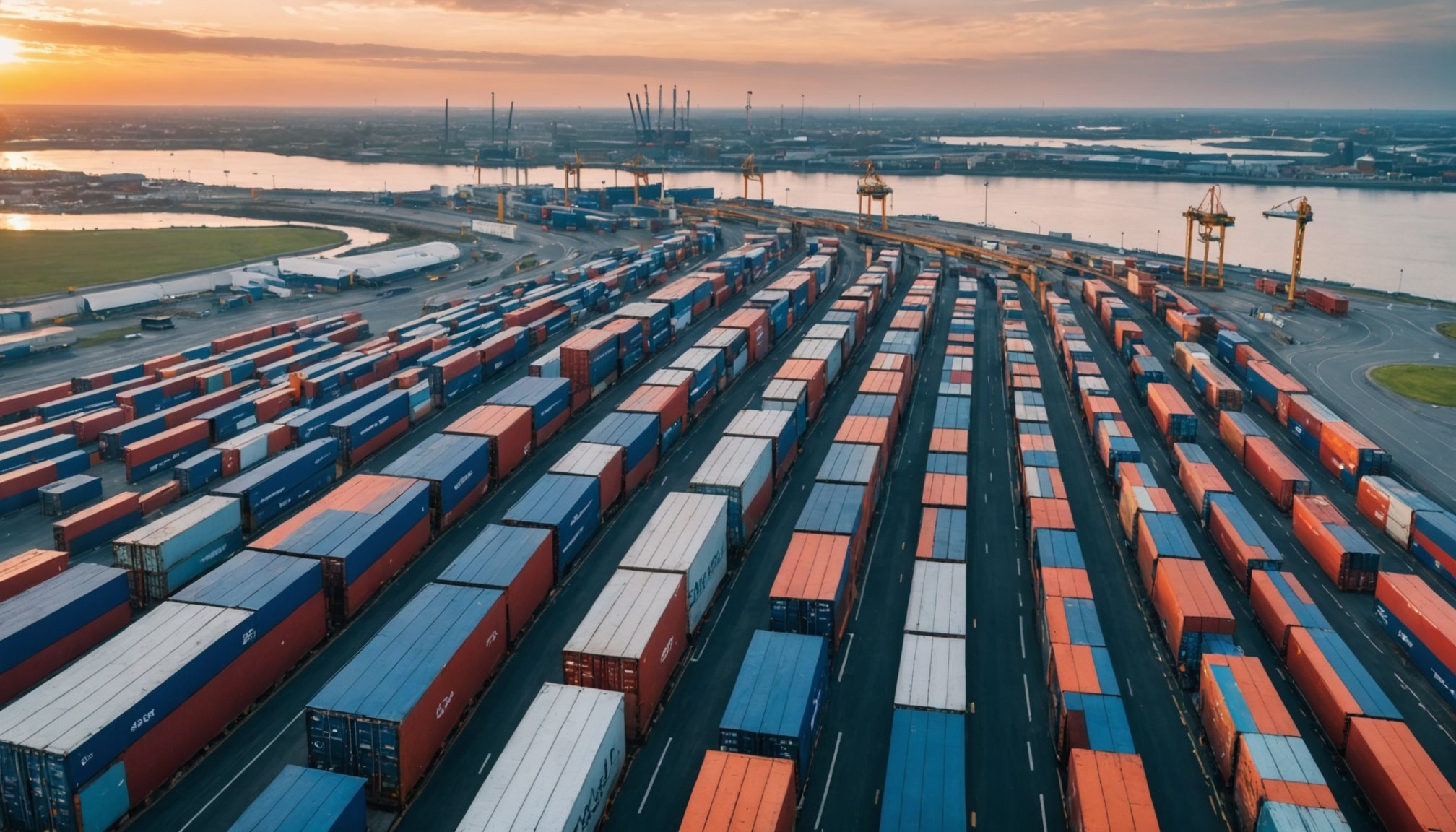The logistics industry in the UK stands on the brink of a revolution, driven by AI-driven predictive analytics. These cutting-edge technologies are reshaping operations, enhancing efficiency, and cutting costs. With immense data at their disposal, companies can now anticipate challenges and respond proactively. This transformation not only improves supply chain management but also elevates customer satisfaction. Explore how these advancements are unlocking new possibilities and setting the stage for a smarter, more resilient logistics sector.
Overview of AI and Predictive Analytics in Logistics
In today's rapidly evolving logistics landscape, AI in logistics is a game-changer, revolutionising how companies manage their supply chains. At the core of this transformation lies predictive analytics, a sophisticated technology that uses historical data, machine learning algorithms, and statistical techniques to forecast future outcomes. By analysing patterns and trends, predictive analytics enables logistics companies to anticipate demand, optimise routes, and reduce operational costs.
Also to discover : Transforming Education: The Impact of Interactive AI Tools on Learning in UK Schools
Logistics transformation through AI-driven predictive analytics is not just a trend but a necessity. The ability to predict potential disruptions and adjust operations accordingly ensures a more resilient supply chain. For instance, by forecasting demand surges, companies can adjust their inventory levels, preventing stockouts or overstock situations. This proactive approach enhances efficiency and customer satisfaction.
Historically, the integration of AI into logistics began with simple automation tasks, gradually evolving into complex systems capable of real-time decision-making. The journey from basic automation to advanced predictive analytics highlights the sector's commitment to innovation and efficiency. As AI continues to mature, its role in logistics will only expand, offering even more sophisticated solutions to age-old challenges.
Have you seen this : Revolutionizing Traffic Flow: The Role of AI in Smart City Management Across the UK
Transformative Benefits of AI-Driven Predictive Analytics
In the dynamic world of logistics, the benefits of predictive analytics are profound, reshaping how companies approach their operations. At the forefront is the enhancement of operational efficiency through data-driven insights. By leveraging these insights, logistics firms can streamline processes, resulting in reduced waste and increased productivity.
Predictive analytics also brings about improved forecasting accuracy. This precision allows companies to manage inventory more effectively, ensuring that stock levels align with demand fluctuations. By anticipating these changes, businesses can avoid costly stockouts or overstock scenarios, thereby optimizing resources.
Moreover, the optimization of supply chain management and routes is a crucial advantage. Predictive analytics enables companies to determine the most efficient paths for transportation, reducing transit times and fuel consumption. This not only cuts costs but also enhances delivery reliability, contributing to overall customer satisfaction.
Ultimately, the integration of AI-driven predictive analytics into logistics facilitates smarter decision-making improvements. By providing a clearer picture of potential future scenarios, companies can make informed choices that bolster resilience and competitiveness in the market.
Challenges and Considerations
Incorporating AI into logistics introduces a range of challenges in AI adoption. One primary obstacle is the implementation hurdles faced by companies, including the need for substantial upfront investments in technology and infrastructure. This can be daunting, particularly for smaller firms with limited resources. Additionally, the complexity of integrating AI systems with existing logistics operations often requires significant overhauls and can disrupt current workflows.
Another critical concern is data privacy. As predictive analytics relies heavily on vast amounts of data, ensuring that this data is secure and compliant with privacy regulations is paramount. Companies must navigate complex legal landscapes to protect sensitive information while leveraging data for analytics. This requires robust data governance policies and advanced security measures to prevent breaches and unauthorized access.
Moreover, the successful adoption of AI in logistics hinges on having a skilled workforce. There is a pressing need for training programs that equip employees with the necessary skills to manage and interpret AI-driven insights. Without a knowledgeable team, even the most advanced AI systems may fail to deliver their full potential. Therefore, investing in workforce development is crucial for overcoming these challenges and maximizing the benefits of AI in logistics.
Real-World Applications and Case Studies in the UK
In the realm of UK logistics, the integration of AI has led to transformative changes, with several firms setting benchmarks through successful implementations. These AI applications have not only enhanced efficiency but also set a precedent for others in the industry to follow.
One notable example is the case of a leading UK-based logistics company that harnessed predictive analytics to optimize its delivery routes. By analysing historical traffic data and predicting future congestion patterns, the company achieved a significant reduction in transit times and fuel costs. This case study highlights the measurable impacts of AI, demonstrating how data-driven insights can lead to tangible operational improvements.
Another case study involves a UK retailer that employed AI to forecast demand more accurately. By integrating machine learning algorithms into their inventory management system, they managed to reduce stockouts by 30% and cut excess inventory by 20%. This not only improved customer satisfaction but also maximized resource utilization, showcasing the practical benefits of predictive analytics.
From these early adopters, several lessons emerge. Firstly, the importance of aligning AI initiatives with strategic business goals cannot be overstated. Secondly, the need for robust data infrastructure is critical to support AI-driven insights. Lastly, fostering a culture of innovation and adaptability within the organization is essential for embracing the full potential of AI applications in logistics. These lessons pave the way for future advancements and widespread adoption across the sector.
Statistical Insights Supporting the Impact of AI
In the evolving landscape of logistics, statistics in logistics provide a compelling narrative of the transformative impact that AI and predictive analytics have on the industry. Through detailed AI impact data, companies can quantify efficiency gains and cost reductions, offering a clear picture of the advantages of AI integration.
Industry reports and surveys consistently showcase a growing trend in AI adoption, with metrics indicating a significant reduction in operational costs and improved delivery times. For instance, logistics firms employing AI-driven predictive analytics have reported up to a 25% decrease in fuel consumption and a 30% reduction in transit times. These statistics highlight the tangible benefits of embracing AI technologies.
A comparative analysis of traditional logistics operations versus AI-driven systems further underscores these advantages. Traditional methods often rely on reactive strategies, leading to inefficiencies and increased costs. In contrast, AI-driven logistics leverage predictive analytics metrics to anticipate disruptions and optimize processes proactively. This shift not only enhances operational efficiency but also boosts customer satisfaction by ensuring timely deliveries.
By examining these statistical insights, it becomes evident that AI is not just a technological advancement but a strategic imperative for logistics companies aiming to remain competitive in a rapidly changing market.
Future Developments and Trends in AI-Driven Predictive Analytics
As the logistics sector continues to evolve, the future of AI in logistics is poised for significant transformation. Predictions indicate that AI technologies will become even more integral, driving enhanced efficiency and innovation. This evolution is expected to streamline operations further, offering logistics companies unprecedented capabilities in managing supply chains.
Emerging Trends
Several emerging trends are set to shape the future of predictive analytics in logistics. One notable trend is the increasing integration of AI with Internet of Things (IoT) devices. This combination will enable real-time tracking and monitoring of goods, providing data-driven insights for more accurate decision-making. Additionally, the rise of autonomous vehicles and drones is expected to revolutionise delivery processes, reducing transit times and operational costs.
Another trend is the advancement of AI algorithms, which will enhance the precision of predictive analytics. As machine learning models become more sophisticated, they will offer deeper insights into consumer behaviour and market dynamics, allowing companies to anticipate changes with greater accuracy. This will enable logistics firms to remain agile and responsive in a rapidly changing environment.
Regulatory Impact
The potential impact of regulatory changes on AI implementation cannot be overlooked. As governments worldwide introduce new data protection and privacy laws, logistics companies must adapt to ensure compliance. These regulations may influence how data is collected, stored, and analysed, necessitating robust data governance frameworks. While these changes present challenges, they also offer opportunities for companies to build trust with consumers by demonstrating a commitment to data security and ethical AI usage.
In conclusion, the future of AI-driven predictive analytics in logistics is bright, characterised by technological advancements and emerging trends that promise to reshape the industry. By staying ahead of these developments and navigating regulatory landscapes, logistics companies can harness the full potential of AI to drive efficiency and innovation.
Practical Guidance for Implementation
Implementing predictive analytics into logistics operations requires a strategic approach to ensure success. A step-by-step guide can help businesses navigate this complex process effectively.
Step-by-Step Guide
-
Assess Current Capabilities: Begin by evaluating existing logistics processes and identifying areas where predictive analytics can add value. Understanding current strengths and weaknesses is crucial.
-
Define Clear Objectives: Establish specific goals for the adoption of predictive analytics, such as improving delivery times or reducing costs. Clear objectives will guide the entire implementation process.
-
Select Technology Partners: Choosing the right technology partners is vital. Look for partners with experience in logistics and a proven track record in implementing predictive analytics solutions. They should offer scalable solutions that can grow with your business.
-
Develop a Data Strategy: Ensure that data collection and management processes are robust. Predictive analytics relies heavily on data, so having a well-structured data strategy is essential for accurate insights.
-
Pilot and Iterate: Start with a pilot project to test the predictive analytics solution. Gather feedback, measure outcomes, and make necessary adjustments before a full-scale rollout.
Key Considerations
-
Technology Integration: Seamless integration of AI into existing logistics operations is crucial. This may involve upgrading infrastructure or training staff to use new systems effectively.
-
Change Management: Implementing predictive analytics may require significant changes in workflows. Prepare for this by fostering a culture of innovation and adaptability within the organization.
-
Continuous Improvement: Predictive analytics is not a one-time implementation. Continuously monitor performance and refine strategies to ensure ongoing success.
By following these guidelines, businesses can effectively integrate predictive analytics into their logistics operations, enhancing efficiency and competitiveness.






